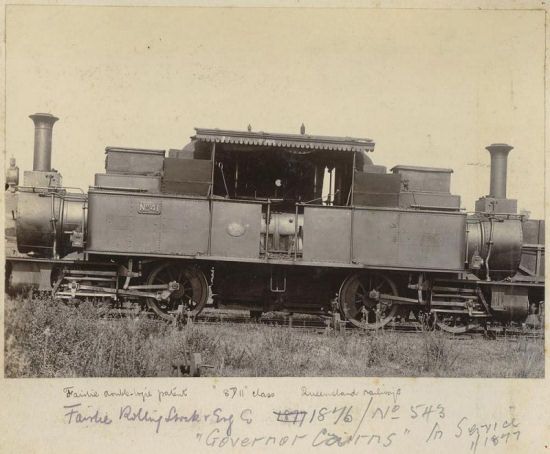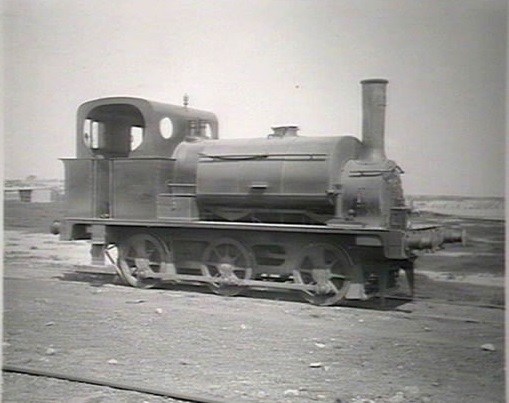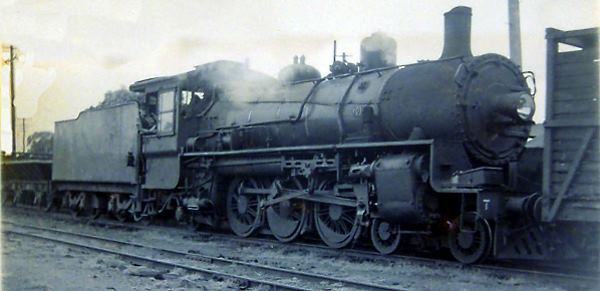Vulcan Foundry Locomotives in Australia
The first Vulcan Foundry locomotive to come to Australia arrived in late 1876 or early 1877.
According to records from Vulcan, the locomotive was originally destined for Norway but was instead delivered to the Queensland Government railways. (How true those records are is open to debate because the locomotive list that dates back to the early years is not guaranteed to be entirely accurate.)
It was an 0-4-0+0-4-0 Fairlie tank locomotive and possibly carried Robert Fairlie nameplates when it left the factory but once it got to Queensland it was named Governor Cairns … and you can read more about it here.

The first Vulcan Foundry locomotive to come to Australia seen here some time after 1882
1876
The next order from Australia was placed in 1876 by T Briscoe and Sons for a standard gauge 0-6-0 saddle tank loco that was used by contractors constructing railway lines in various parts of NSW before being sold to the Public Works Department and then onto a north coast timber company in 1920.
Queensland was back in 1876 with an order for three 2-4-0 locos that entered service in Queensland in 1877. All three were written off in 1902 after spending most of their life working in the northern parts of Queensland
1878
In 1878 New South Wales appeared in the works locomotive list when three 0-6-0 saddle tank locos were delivered. These small saddle tank locos became the 127 Class and then reclassified as the P(127) Class and then the U(127) Class. They were originally numbered 127, 128 and 129 on the NSWGR.
They were used on various light lines around Sydney and as far south as Yass.

NSWGR 127 Class – later reclassified as the (P)127 Class
1882
Vulcan Foundry delivered more locos to the NSWGR in 1882 when six 0-6-0 tank were delivered for suburban passenger working in Sydney. These became the 285 Class and were numbered 285 to 290 in the old classification system then in use in NSW.
Later they were reclassified as the Z18 Class.
1886
In 1886 Vulcan delivered 12 Class 373 4-4-0 express locomotives to the NSWGR. These were numbered 373 to 384 when they entered service. They were not very successful and as soon as the C32 was introduced these locos were relegated to branch lines around the State.
These locos were later reclassified as the Z17 Class and they were the last steam locomotives that the Vulcan Foundry delivered to the NSWGR.
1902 – 1903
In fact it was another 16 years before another Vulcan product would be delivered to Australia and that was part of the E Class order of 4-6-2 locomotives delivered to the WAGR in 1902 and 1903.
Vulcan Foundry also delivered an 0-6-0 tank loco to the WAGR in 1903.
Another 46 years passed before another Vulcan locomotive came to Australia.
1950 – 1954
In 1950 the Queensland Government Railways received 35 4-6-2 locos from Vulcan and these became the first of the BB181/4 Class.

A photo from a 1961 negative of one of the Vulcan Foundry built BB181/4 locos shunting at Harristown. At this stage the loco was just 10 years old. Photograph by Kimball Thurlow
In 1951 the Tasmanian Government Railways received eight H Class 4-8-2 locomotives. These locos were based on the same design that Vulcan had built for use in Africa during the Second World War.
The final group of steam locomotives built by the Vulcan Foundry arrived in Australia in 1954. These were quite handsome J Class 2-8-0 goods locomotives built for the Victorian Railways.
Vulcan only produced steam locomotives for another 2 years and by the time the J Class were in production Vulcan was already producing diesel locomotives. All locomotive production ceased in 1970.
The end
Vulcan Foundry was taken over by English Electric in 1957 but continued to trade under its own name.
The business continued on as a diesel engine builder after 1970 and it built diesel engines for a variety of applications and went through a number of changes to the company name until all production ceased at the factory in 2002.
After 172 years the business that had once been the Vulcan Foundry that had carried on business at Newton-le-Willows, Lancashire disappeared into the history books.
Vulcan Foundry Locomotives that came to Australia:
1 x 0-4-0+0-4-0 tank loco ( to QR)
4 x 2-4-0 locos (all to QR)
12 x 4-4-0 locos (all to NSWGR)
10 x 0-6-0 tank locos (9 to NSWGR and 1 to a private contractor)
35 x 4-6-2 locos (all to QR)
60 x 2-8-0 locos (all to VR)
8 x 4-8-2 locos (all to TGR)
References
Grunbach A, A Compendium of New South Wales Steam Locomotives, Australian Railway Historical Society, New South Wales Division 1989. Australian Print Group, Maryborough Vic
McCarthy K, Gazetteer of Industrial Steam Locomotives, Illawarra District N.S.W. Australian Railway Historical Society (N.S.W. Division) 1983. No printer listed.
Oberg L, Locomotives of Australia 1850s – 1990s Third Edition, Kangaroo Press 1996. Colorcraft Ltd.
Enuii website, Vulcan Foundry Locomotive List – http://www.enuii.com/vulcan_foundry/locomotive_list.htm
Qrig website, BB18¼, http://www.qrig.org/motive-power/locomotives/steam/bb18-class
Qrig website, A10 Fairlie – Originally A Class – http://www.qrig.org/motive-power/locomotives/steam/a10-fairlie-originally-a-class
Rail Album website, Vulcan Foundry Works List – http://www.railalbum.co.uk/articles/vulcan01.htm
Wikipedia website, Vulcan Foundry – https://en.wikipedia.org/wiki/Vulcan_Foundry
Photos courtesy of the State Library of Queensland and the Power House Museum, Sydney